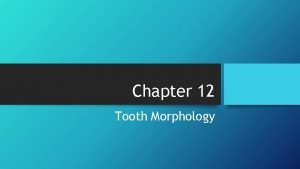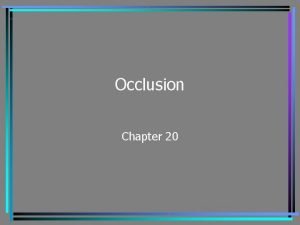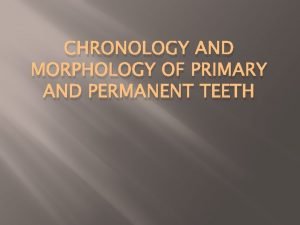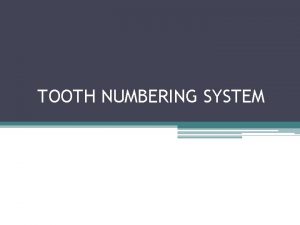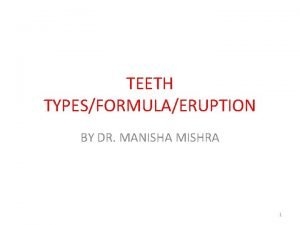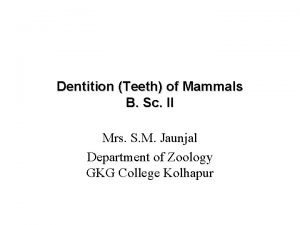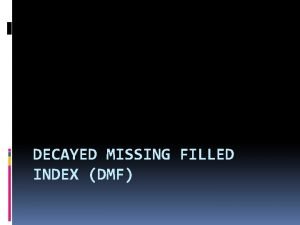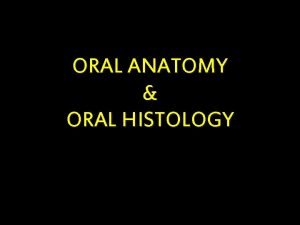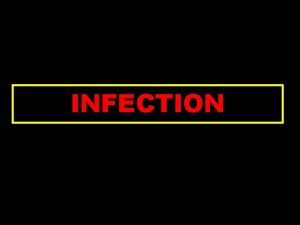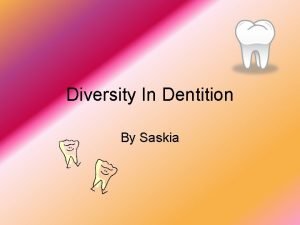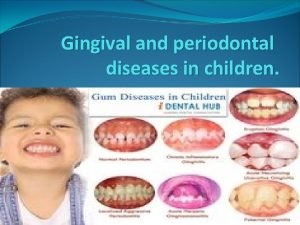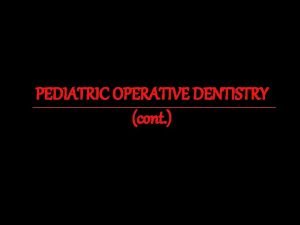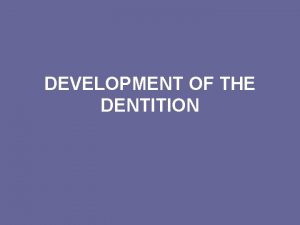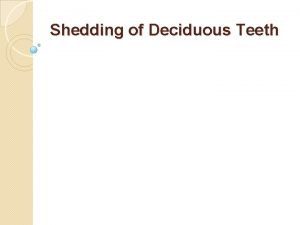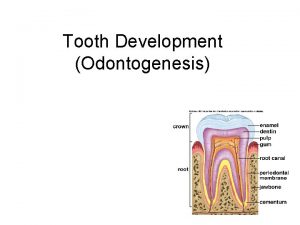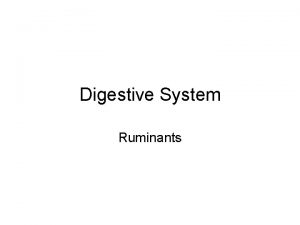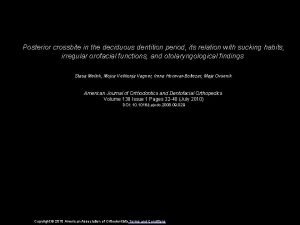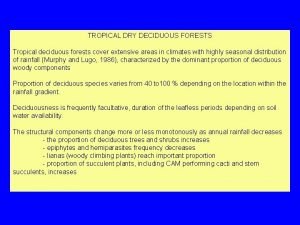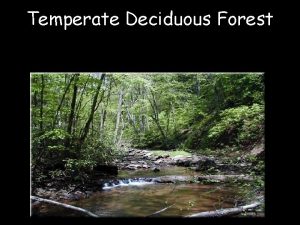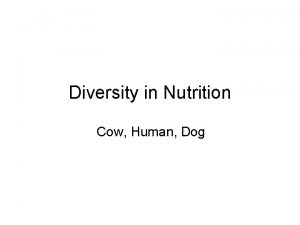Dentition Deciduous teeth There are 20 primary teeth






















- Slides: 22

Dentition – Deciduous teeth • There are 20 primary teeth (10 at every jaw): – 8 incisors, 4 canines and 8 primary molars. • By 4 months in utero: Teeth begin to form in bone • By Age 2: All deciduous or ‘baby’ teeth have erupted

Dentition – Permanent Teeth • There are 32 permanent teeth (16 at every jaw): – 8 incisors, 4 canines, 8 premolars, and 12 molars • By Age 6: Permanent teeth have started to erupt • By Age 12: Second set of molars have emerged • Age 17 -24: Wisdom teeth have erupted

Dentition • The number of teeth of each type of tooth is written as a dental formula for one side of the mouth. • The teeth are numbered in order: – Incisors, Canines, Premolars, Molars – I: C: P: M

• Juvenile skull less than 6 -7 years old. • Dentition: 2: 1: 2 – – 2 incisors 1 canine 2 premolars 0 molars

• Skull from a 12 year old male. • Dentition: 2: 1: 2: 2 – – 2 incisors 1 canine 2 premolars 2 molars – Wisdom tooth is under the surface of the gum

• Adult male skull • Dentition: 2: 1: 2: 3 – – 2 incisors 1 canine 2 premolars 3 molars

Human developmental phases and general characteristics used for aging • • Perinatal Neonate Infant/toddler Late childhood Adolescence Early adulthood Middle and late adulthood

Perinatals - before birth • The age of perinatals, individuals not yet born, can be determined by looking at bone size. • This is a fairly accurate estimate due to the fact malnourishment will not affect growth; the fetus will take necessary nutrients from the mother.

Neonates ~ 0 -6 or 7 months • Prove very difficult to accurately determine the age because of individual variation of development (genetics & nourishment). • Neonates have no teeth • Areas of the skeleton have not fused together (especially the cranium and pelvis).

Infants and toddlers 6 or 7 months ~ 2 years • All (20) deciduous teeth erupted by age 2. • Permanent teeth (under ‘baby’ teeth) start to form at birth, thus the formation of permanent teeth is a relatively good age determinant. • Some ossification has begun, this is highly variable at this age

Late childhood ~ 6 years -11 years • Late childhood is when the permanent teeth begin to come in. • More bones begin to ossify. • Second set of molars come in at about age 12.

Adolescence ~12 - 18 years • Adolescence shows increased long bone length and fusion of the ends (or cap) to the shaft. • This epiphyseal union/fusion is a particularly useful age technique. (see skeletal diagrams for age references).

Age range ~ 20 – 35 ish • Young adults and older adults have several methods of age determination: • closure of the cranial sutures; morphology of rib-ends, • pubic symphysial • microstructure of bone and teeth; wear on teeth, incremental layers of cementum

• Age of epiphyseal fusion. • First number is approximate age at which fusion first begins. • Second number is approximate age at which fusion is complete.

Diagram of human shoulder and arm • Practice Q’s • Region A has just begun to fuse • Region B, fusion is approximately 90% complete. • There is a complete epiphysial union at location C. • Fusion at distal end of radius and ulna is approximately 5060%. • What is the approximate age of this person?

Answer… Age 18 -20 Age range 18 -25 Age range 15 -19 Age range 13 -18 Age range 15 -23

Practice Q’s… • Description of partial skull and partial pelvis found in a remote wooded area: • Skull - coronal suture is approximately 60% fused, lamboidal suture is fused and semi smooth, frontal area (forehead) has a 40 0 angle. • The subpubic angle is approximately 50 0, and the pubic bone (pubic symphysis) is completely fused. • What is the sex and age of this individual?

Answer…. • Skull - coronal suture is approximately 60% fused, ( age range 30 -35) lamboidal suture is fused and semi smooth (age range closes at 30, get more snooth over time), frontal area (forehead) has a 40 0 angle (male less than 90 0). • The subpubic angle is approximately 50 0, (male 50 -800) and the pubic bone (pubic symphysis) is completely fused (age 20 -23).

Adult dentition and age range of tooth eruption

Frontal view of adult dentition, numbers for identification and tooth name.

Maxilla of female found in wooded area after a suicide. Did this woman have her wisdom teeth?

Maxilla of female found in wooded area after a suicide. Did this woman have her wisdom teeth? YES 2: 1: 2: 3
 Insidan region jh
Insidan region jh Chapter 12 tooth morphology
Chapter 12 tooth morphology Orthognathic prognathic retrognathic
Orthognathic prognathic retrognathic Incisal labiality
Incisal labiality Dental lamina
Dental lamina Universal tooth numbering system deciduous
Universal tooth numbering system deciduous Dr manisha mishra
Dr manisha mishra Tricodonta
Tricodonta Chapter 17 oral pathology short answer questions
Chapter 17 oral pathology short answer questions Dmft index calculation example
Dmft index calculation example Linguo incisal ridge
Linguo incisal ridge Intact dentition
Intact dentition Diastema in cows
Diastema in cows Teeth disking
Teeth disking Retrocuspid papilla
Retrocuspid papilla Class 2 cavity preparation pediatric
Class 2 cavity preparation pediatric Enamel rods in primary vs permanent teeth
Enamel rods in primary vs permanent teeth Yellow magenta and cyan are the ___
Yellow magenta and cyan are the ___ Tema there is there are
Tema there is there are What part of speech is open
What part of speech is open There is there are negative form
There is there are negative form There is there are
There is there are There isn't any
There isn't any

